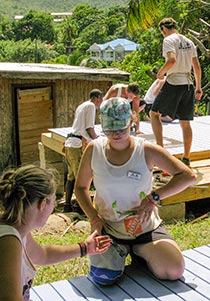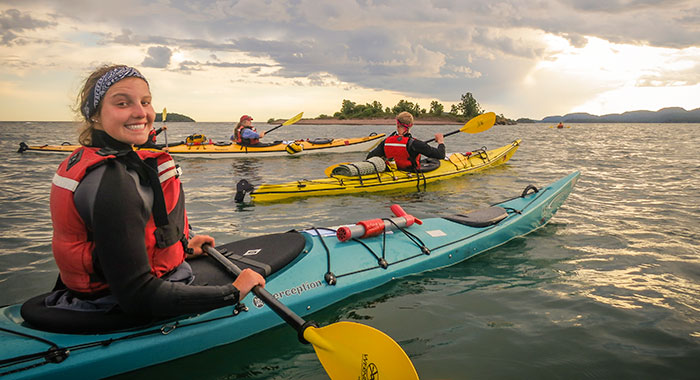Generation Gap
It was around the age of 30 that I began telling myself, “I will not become my mother, I will not turn into my mother, I will not become my mother …” – repeating it as if it was an unbreakable vow.
Let me clarify here, my mother was a wonderful person. Like her, I am slow to anger, but in this particular instance, an uncharacteristic lapse in manners by the students I was traveling with had gotten under my skin. Rather than returning to the bunkhouse and joining them for the rest of the night, I just walked out into the woods, rolled out my sleeping pad and sleeping bag, lay down, and gazed up at the stars twinkling through the canopy of trees.
Imagine if you will what it was like to constantly be around a group of college freshmen for three-and-a-half months. My youthful companions had boundless energy, communicated in a language that I barely understood, and had the ability to stay up all night with little or no sleep. Almost all of the time I found them great good fun. As a group, they were generally inquisitive, and grateful for the opportunity to complete their first college semester via our traveling Gap Experience campus – a community numbering just the 10 of us. But eight of those souls were 18, and I was 50-plus, and our biorhythms and level of vitality were not always in sync.
This night, I’d left the student group to create a little breathing room for both parties. We were visiting a service-learning site in the hardscrabble foothills of rural Appalachia, and a couple of the students had carelessly run up a $528 overage on our host’s internet data plan – despite house rules to the contrary. Most of the students really didn’t understand that access to an open source “free” internet is not something that everyone has. But I’d felt disappointed and embarrassed.
And now there I lay, listening to the sultry sound of crickets and dogs barking off in the distance, questioning whether or not I should go back to the bunkhouse and apologize for my own self-indulgent outburst; fearful that my juvenile behavior would have all sorts of negative ramifications. Instead, I simply fell asleep.
Leading the first group to experience St. Norbert’s Gap Experience – leading them across a continent, logging more than 7,000 road-miles; taking them to visit a men’s homeless shelter in the heart of downtown Chicago late at night; or banging boards together in the humid, mid-day Caribbean heat, soaked in sweat, building a home for a family that was previously living in squalor; trying to convince them that going without a shower for 26 straight days; or dangling off the end of a rope from a craggy granite rock face over the open waters of Lake Superior would teach them more about themselves than they would learn in any typical college classroom – does this sound like fun, or does it sound more like a variation on a “Survivor” series? Either way, spending that kind of intense time with students in the field makes for an experience that I deeply believe in.
I had not felt so alive and genuinely enriched as a teacher since the time I had first designed such an off-campus program at St. Lawrence University. Leading programs like these, I found I would sometimes get a bit confused as to which hat I was wearing at any given time. By turns I had to be friendly confidante, thoughtful mentor, sagacious professor, enthusiastic cheerleader, sensible program director or stern surrogate parent.
When I awoke in the morning after that one night in Appalachia and ran into the program assistant, Jon Mallek ’13, I asked him – not without some apprehension – how things went the night before. He let me know that the students had been quite surprised when I left them the previous night. But he said that, after talking as a group, they realized that any thoughtless action on their part had the potential to jeopardize future partnerships with our hosts. These were people who not only deserved our consideration but who, through their deep and significant ties to the larger community, functioned as our gateway to various service-learning projects in the area.
Beyond its underlying objectives of academic soundness and personal enrichment, St. Norbert’s Gap Experience was designed to incorporate service-learning into its overall structure. To me, this challenge provided students with an opportunity to learn – and not just in theory – one of the fundamental tenets upheld by the Norbertine tradition: Catholic social teaching. At its core, this element of the faith centers on the aim of establishing social justice for all peoples. We, as educators in this tradition, should strive for learning situations that encourage students to live out the ideal, by establishing mutual respect, dignity and equality for all.
What better way to teach this guiding principle than through direct exposure to the myriad social injustices evident worldwide – from the back streets we visited in inner-city Chicago, to the shanty towns we found just blocks away from the cruise-ship tourist zones throughout the Caribbean. Gap students were repeatedly confronted with issues of poverty and wealth.
It is my own strong belief that, by encountering first-hand some of the social injustices at work in both domestic and international settings – and by then engaging in a thoughtful and ongoing critique of their causes – students will be moved at a deeper level to join the work of rectifying the imbalances that occur between the haves and have-nots in our global society.
Teaching and learning can become inherently spontaneous and student-centered when moved from the confines of the classroom into the world at large. Service-learning field experiences are unmatched in their learning potential, from the uniquely collaborative relationships developed outside the classroom, to the deep learning that occurs when students must put into practice “in the real world” what they have theorized about from behind a desk or in a classroom discussion.
As we drove away from our Appalachian host-site, I reflected that it was my job as a teacher to point out or illustrate the ways in which unspoken privilege operates in the world. Still, that particular night’s lesson would simply not have happened had I gone back to my bed in the bunkhouse. The students would have ample opportunity throughout their Gap Experience to contemplate the big and small injustices that exist in our world. And to understand that, at some very basic level, by the simple act of “minding our manners,” they, too, could – and would – be able to do their part in creating a more civil and just society.
 Mind the Gap: Pilot Program 2014-15
Mind the Gap: Pilot Program 2014-15The Gap Experience, an off-campus for-credit adventure, focuses on leadership, service and international travel. Eight students joined the first, pilot, cohort. At press time, 17 were planning on entering the program for the coming academic year.
Segment one: Voyageur Outward Bound School in northern Minnesota.
Segment two: Four Corners School of Outdoor Education in Utah.
Segment three: Service with the David Darst Center in Chicago.
Segment four: Service with the Once Upon a Time organization in Tennessee.
Segment five: A six-week service experience with the Good News Project in St. Lucia gave the students, including Lauren Gambill ’18 (left) and Martha Rausch ’18 (center), the chance to work with an initiative founded by alums of St. Norbert.
Back home: J-Term class and spring semester brought the Gap students home to St. Norbert, where they closed out their first year of college alongside their classmates.
July 3, 2015












